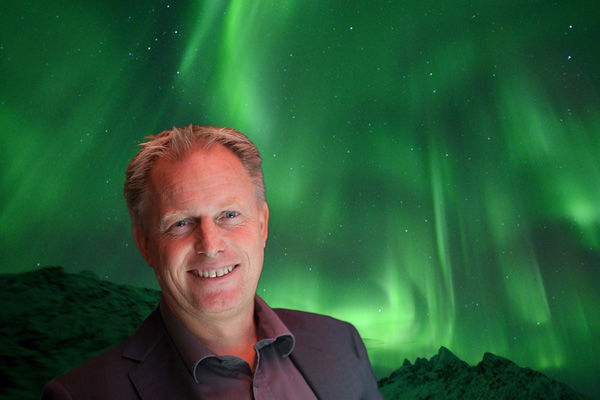The Sun is a medium-sized, powerful star. Stars generally come in pairs.
Ours is all alone, but it has the Earth as a neighbour – and all of us who live here...
... and we value every single ray of sunshine.
The wonderful power of the sun
The Sun is planet Earth’s largest source of energy, by far. And solar power is growing faster than ever. If this trend continues, up to 30 per cent of the world’s demand for electricity could be met by solar power by 2040.
“The Sun is an almost inexhaustible source of energy,” says solar physicist Pål Brekke.
The renowned senior advisor at the Norwegian Space Agency knows more about the power of the Sun than almost anyone else in Norway, and what a power that is.
“In one second, the Sun emits enough energy to keep the whole of Norway supplied with electricity for over 600 million years!” he adds.
Brekke’s father worked at a solar observatory, so it was natural for Pål Brekke to pursue solar research.
Among other positions, Brekke was Deputy Project Scientist for ESA and NASA’s SOHO project, a solar satellite that was launched in 1995 and is still orbitting around the Sun.
Even after a long career in solar research, he still gets stars in his eyes when he thinks about what the Sun means to us.

“The Sun may look calm and rather boring to us down here on earth. But from space we can see that it is an extremely dynamic star, which is constantly ‘coughing and spluttering’. It ejects clouds of charged gas, high-energy particles and vast quantities of X-ray and UV radiation. Such solar flares can knock out parts of our technology-based society and damage satellites, and they could prove deadly for astronauts on their way to the Moon or Mars.”
The extreme amount of power involved is difficult to comprehend. The Sun produces 385 million billion billion watts. That would certainly get the solar panels at the cabin going! Fortunately, the Earth receives only a tiny fraction of the Sun’s total energy output. And that is more than enough, according to Brekke.
“Every year, the Earth receives 15 000 times more energy than the entire global population consumes,” he explains, before adding:
“And when you think about all the solar energy bombarding the Earth, it’s no surprise that the use of this energy source is growing fast.”
Did you know that sunlight promotes the body’s production of serotonin, a neurotransmitter that stabilises our mood?
Solar power – part of the climate solution
Just ten years ago, solar power accounted for a tiny fraction of the world’s energy production. Now, power production from solar panels is growing faster than any other form of energy.
But solar energy has been there all along. Why is it only now becoming so attractive?
“Because solar power is part of the fundamental solution. If we are to reach our climate goals, we must use all sources of renewable energy. And the cost of producing solar power has recently fallen dramatically, making it a more attractive choice,” says Hilde Holden, Acting Vice President, Strategy, in Statkraft's European Wind and Solar business area.
“At Statkraft, we are primarily concentrating on large solar power projects. But the great thing is that you can also install it in off-grid mountain cabins or on the roof of your car. Solar panels offer a huge range of opportunities.”

Solar power is a climate-friendly, clean and green energy source that is gaining traction around the world and also in Norway. For example, in developing countries where many areas are without access to the power grid, solar power is now one of the main sources of electricity.
Together with wind power, solar power is the cheapest source of energy in the world. Lower production costs for solar panels combined with rising demand for renewable energy, means that solar power is now growing faster than any other source of energy.
“We have waited a long time for solar power to become cheap and competitive. Now we are focussing a great deal of attention on it,” says Holden.
According to Statkraft’s Low Emissions Scenario, solar power will exceed other forms of renewable energy in the long term and will be the world’s biggest source of electricity by 2035.
But what happens when the sun doesn't shine?
“One of the main challenges with solar power is that we can only produce it when the sun is shining. That’s why solar power is both an opportunity and a challenge. The key is to exploit its strengths,” says Hilde Holden.
Because solar power cannot always be generated on demand, output is not evenly distributed. Fortunately, there are ways to ensure enough power around the clock.
“We have a sales organisation that is extremely good at energy management and trading, and we have teams that are good at calculating short and long term electricity production and demand. They make agreements and ensure that we have enough output 24/7, 365 days a year,” says Holden.
Another way of safeguarding electricity supplies is the use of so-called hybrid products. During periods when solar power production exceeds demand, some of this surplus can be stored in batteries. This allows the power to be portioned out when it is needed.
Did you know that the Earth is being hit by 174 quadrillion (a thousand trillion) watts of solar energy at any one time?
Major investment in solar energy
All in all, the future for solar power looks exceedingly bright. Statkraft is currently investing heavily in this form of energy, not least in 2020 with the acquisition of Solarcentury, a leading global solar power company. The acquisition is a milestone for Statkraft and an important step on the road to becoming a leading global provider of solar and wind power.
Solarcentury is a pioneer in the solar energy field and a major international company with solar power plants in several countries. Even before the acquisition, Statkraft had solar farms in the Netherlands and Ireland, among others, but on a completely different scale to Solarcentury.
“Solarcentury has built many more solar power projects than Statkraft. They bring with them a highly competent workforce experienced in solar power, processes and routines. Statkraft has its strengths, Solarcentury has theirs. Together, we aim to be at the forefront in developing a great deal of solar power! We have the same ambition, commitment and vision when it comes to preventing climate change. I think that’s really cool,” says Holden.
Norway is not Statkraft’s primary market when it comes to solar power. The main focus is on countries which enjoy a lot of sun, such as Spain. However, Holden does not rule out more projects in countries such as Norway in the longer term.
“With better batteries and solar panels, Norway could become more relevant. And who knows? We might end up driving around with solar panels on the roofs of our cars,” she says with a smile.
And when does Hilde Holden smile the most? When the sun is shining, of course. And like many Norwegians, preferably in the mountains.
“With white, snow-clad mountain plateaus glittering in the sun!”
The Talayuela solar power plant in Cáceres in the Extremadura region of Spain is one of the largest in Europe. With more than one million solar panels, the plant has a capacity of 300 MWp (watt peak) and produces about 600 GWh annually. This solar power plant was one of many that came with Statkraft's acquisition of Solarcentury in 2020.